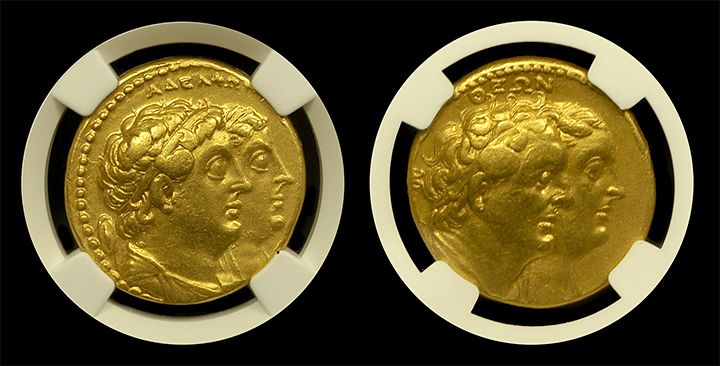
Many customers ask us, "What is the largest ancient gold coin?" We tell them, you’ve come to the right place! Only one ancient gold coin struck holds that title. The Gold Octodrachm was by far the largest gold coin ever struck in the ancient world. These heavy weights were a most common denomination of its day. Importantly, other large denominations like the tetradrachm (four drachms), the pentadrachm (five drachms) were also common. However, the Octodrachm (an eight-drachm coin) was the largest.
Gold Octodrachms were struck over 2,300 years ago. They were produced during the Hellenistic period in Ptolemaic Egypt. No other kingdom or empire in the ancient world comes close to producing such a large gold coin. Above all, Ancient Egypt was known to be a country of remarkable wealth and prosperity. The Ptolemaic Empire displayed their economic clout by drawing thousands of mercenary soldiers into Egypt’s service.
Egyptian Gold Octodrachms were struck in different designs during the many different reigns. In particular, the coins paid homage to their leaders. For instance, a Dynastic Octodrachm, depicts the founders of the dynasty. It features Ptolemy I and his wife Berenice I on the reverse of the coin. The obverse shows portraits of Ptolemy II and Arsinoe II.
Ptolemy II Gold Octodrachm
Each Octodrachm contains just under an ounce of pure gold. This represented an enormous amount of wealth for a person who lived in Ancient Egypt. Today, collectors are impressed with the remarkable designs and craftsmanship of these coins. For a 2,300 year old coin they look absolutely stunning. The Ptolemy II Gold Octodrachm example, in the video below, has been graded by NGC Ancients. Furthermore, it is in Choice Very Fine condition. This makes it affordable to some collectors. A mint state example however, would be far too expensive for most coin enthusiast.
So, when someone asks you, what is the largest ancient gold coin is? You can tell them that it is call the Gold Octodrachm. In conclusion, you can say that one in perfect condition would be way out of their reach! Except, maybe in a museum.
